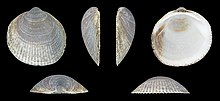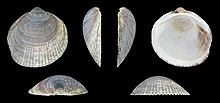Glycymeris nummaria is a species of saltwater clam, a marine bivalve mollusc in the family Glycymerididae, the bittersweet clams.
| Glycymeris nummaria Temporal range:
| |
|---|---|

| |
| Right valve of Glycymeris nummaria | |

| |
| Left valve of Glycymeris nummaria | |
| Scientific classification | |
| Domain: | Eukaryota |
| Kingdom: | Animalia |
| Phylum: | Mollusca |
| Class: | Bivalvia |
| Order: | Arcida |
| Family: | Glycymerididae |
| Genus: | Glycymeris |
| Species: | G. nummaria
|
| Binomial name | |
| Glycymeris nummaria | |
Synonyms
edit- Arca insubrica Brocchi, 1814
- Arca nummaria Linnaeus, 1758
- Glycymeris insubrica (Brocchi, 1814)
- Glycymeris violacescens (Lamarck, 1819)
- Pectunculus cor Lamarck, 1805
- Pectunculus nudicardo Lamarck, 1819
- Pectunculus obliquatus Rayneval & Ponzi, 1854
- Pectunculus pilosellus Risso, 1826
- Pectunculus purpurascens M' Andrew, 1854
- Pectunculus reticulatus Risso, 1826
- Pectunculus transversus Lamarck, 1819
- Pectunculus zonalis Lamarck, 1819
Description
editGlycymeris nummaria var. insubrica
Right and left valve of the same specimen:
-
Right valve
-
Left valve
The shell of an adult Glycymeris nummaria can be as large as 60 millimetres (2.4 in). It is quite thick, almost circular in shape, with a sculpture of radiating striae and fine concentric lines. The surface is dull and may be dark or pale brown, but also whitish-yellowish. Inside of the shell is glossy, white or pale yellow, often with irregular brown markings.
Distribution and habitat
editThis species is widespread from Norway to the Mediterranean Sea. It lives in sandy-muddy gravels offshore to depths of about 100 metres (330 ft).
References
edit- Melita Peharda, Marija Crnčević, Ivana Bušelić, Chris A. Richardson and Daria Ezgeta-Balić - Growth And Longevity of Glycymeris nummaria (Linnaeus, 1758) from the Eastern Adriatic, Croatia
External links
edit- Najdek M., Ezgeta-Balić D., Blažina M., Crnčević M. & Peharda M. (2016). "Potential food sources of Glycymeris nummaria (Mollusca: Bivalvia) during the annual cycleindicated by fatty acid analysis". Scientia Marina 80(1): 123-129. doi:10.3989/scimar.04267.23A.